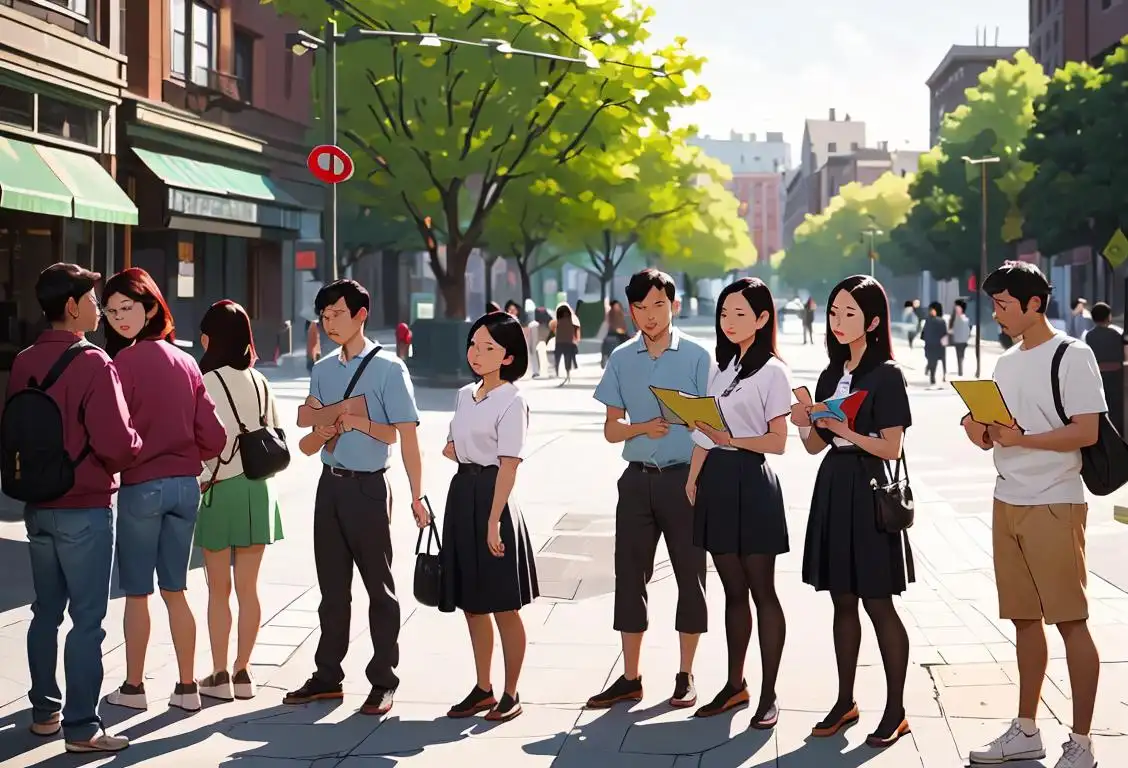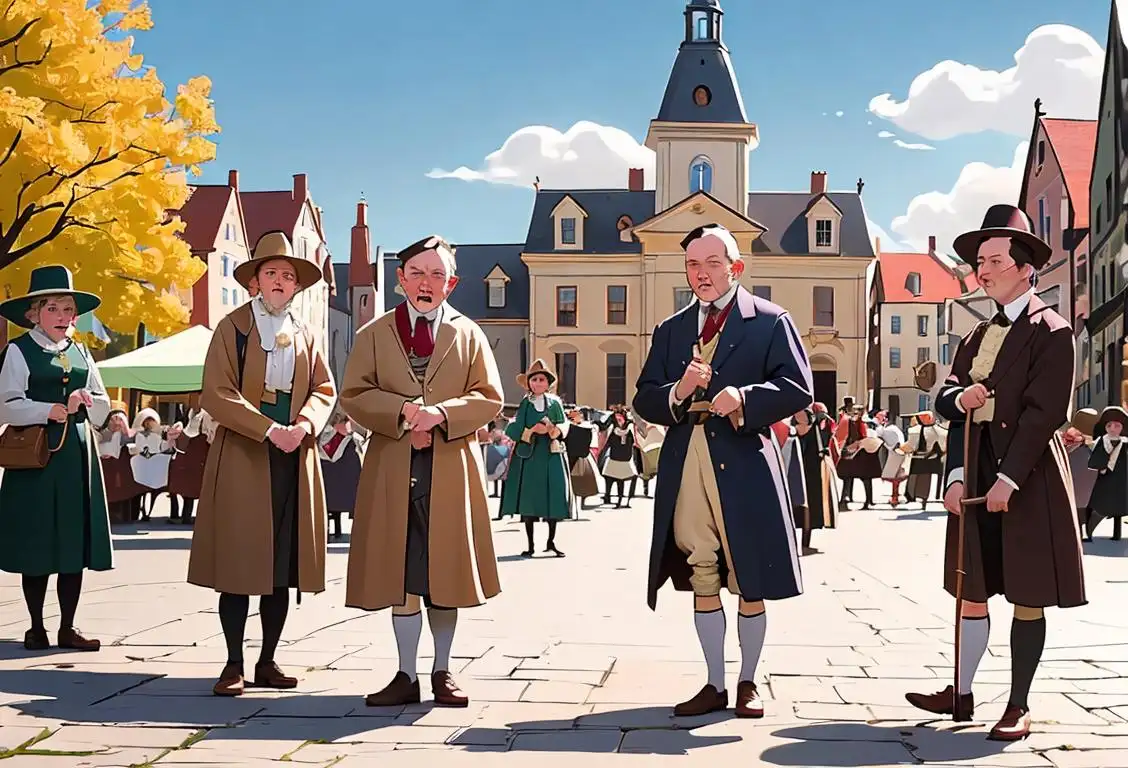National Library Outreach Day

Welcome to National Library Outreach Day! It's time to dust off those library cards and join in the celebration of all things literary. Whether you're a bookworm, a word nerd, or just someone looking for a quiet place to escape the chaos of the world, this day is for you. Prepare to embark on a delightful journey into the fascinating world of libraries and discover the magic they bring to our lives.
When is Library Outreach Day?
It's national library outreach day on the 7th April.
The History of National Library Outreach Day
National Library Outreach Day is a relatively new addition to the calendar of national days. It was first observed on April 7, 2021, and has been gaining popularity ever since. The aim of this day is to raise awareness about the importance of libraries and their vital role in serving communities.
Libraries have traditionally been seen as a place where people can borrow books, but they have evolved into so much more. They are now centers of knowledge, offering a wide range of resources, including e-books, audiobooks, digital media, and educational programs. These community hubs provide opportunities for learning, exploration, and connection.
National Library Outreach Day is a chance for libraries to showcase their services and engage with the public. It encourages librarians and library staff to reach out to their communities, promoting literacy, supporting education, and fostering a love of reading.
How to Celebrate
There are many ways to celebrate National Library Outreach Day. Here are a few fun ideas:
- Visit your local library and immerse yourself in a sea of stories. Pick up a new book, explore a new genre, or discover something unexpected.
- Participate in library-led activities and events. Many libraries organize book clubs, storytelling sessions, author talks, and workshops. Check out what's happening in your neighborhood and join the fun.
- Spread the love for libraries on social media. Share your favorite library memories, recommend great reads, or simply express your appreciation for these wonderful institutions. Don't forget to use the hashtag #LibraryOutreachDay.
Did You Know?
Did you know that the oldest known library in the world is the Library of Ashurbanipal? It was built in the 7th century BCE and housed an impressive collection of over 30,000 clay tablets. Imagine browsing through ancient literature and uncovering the wisdom of the past!
History behind the term 'Library Outreach'
Late 19th century
Emergence of Library Extension
In the late 19th century, the concept of library outreach began to take shape with the emergence of Library Extension. Library Extension aimed to provide library services to underserved communities and individuals who couldn't easily access physical libraries. This movement recognized the importance of making books and knowledge accessible to all, regardless of location or socioeconomic status.
Late 19th century
Emergence of mobile libraries
Mobile libraries began to emerge in the late 19th century, providing access to books and resources to people living in remote areas or those who were unable to visit traditional brick-and-mortar libraries. These libraries often traveled by horse-drawn carts or bookmobiles, reaching out to communities in need.
1920
The Birth of Library Extension
In the early years of the 20th century, the concept of library outreach began to take shape. In 1920, the American Library Association (ALA) established the Library Extension Board, marking the official birth of library extension services. The aim was to bring library services to those who couldn't access them easily, such as people living in rural areas or the physically disabled. This step in history laid the foundation for what would later become known as library outreach.
1905
Establishment of the first library outreach program
In 1905, the American Library Association (ALA) established the first library outreach program. This initiative aimed to extend the library services beyond the physical library building and reach out to underserved communities, including rural areas and neighborhoods with limited access to books and information. The program focused on bringing the joy of reading and learning to those who couldn't easily access the library.
1890
Inception of the modern public library system
In the late 19th century, libraries transitioned from exclusive, subscription-based institutions to important public resources. This shift began in 1890 when the Boston Public Library became the first-ever publicly supported municipal library system in the United States. This marked the inception of the modern public library system, which aimed to provide free access to information and knowledge for all members of society.
1880
Beginning of traveling libraries
In 1880, Melvil Dewey, an American librarian and educator, initiated the concept of traveling libraries. These libraries were designed to reach people living in remote areas who did not have access to books. The aim was to extend the availability of literature and knowledge to as many people as possible, regardless of their location.
1800
The Birth of Public Libraries
In the early 19th century, public libraries started to emerge as places where individuals could access books and educational resources. These libraries aimed to provide information and promote literacy for all members of society. However, their reach was limited to those who visited the physical library buildings.
1920
Establishment of the American Library Association
In 1920, the American Library Association (ALA) was established, serving as the national voice for libraries in the United States. This organization aimed to promote library services and resources, and to advocate for the importance of libraries in communities.
Late 19th century
Early library extension services
During the late 19th century, libraries began to recognize the importance of reaching out to underserved communities. They started offering services beyond the physical library walls, organizing bookmobiles and delivering books to rural areas. This marked the first steps of library outreach.
Late 19th Century
Emergence of Public Libraries
The term 'library outreach' can be traced back to the late 19th century when public libraries started to play a crucial role in providing access to knowledge and information. As the demand for library services grew, librarians realized the need to extend their reach beyond the physical walls of the library building to serve individuals who couldn't visit the library themselves. This marked the beginning of library outreach initiatives.
Late 19th Century
The Emergence of Library Outreach
Library outreach began to take shape in the late 19th century. As more public libraries were established, librarians recognized the need to extend their services beyond the traditional library walls. The concept of library outreach evolved as librarians sought to make their collections and resources accessible to diverse communities and individuals who were unable to visit the library due to various reasons, such as distance, disability, or lack of transportation.
late 19th century
The Emergence of Public Libraries
During the late 19th century, public libraries began to emerge as institutions dedicated to providing access to books and knowledge for all members of society. These libraries primarily served their local communities by offering a range of books and resources. However, they soon realized the need to extend their services beyond their physical walls and reach out to those who were unable to visit the library premises.
1900
Expanding Services
As the demands for knowledge and information grew, libraries realized the need to extend their reach beyond their physical locations. In the early 20th century, libraries began exploring ways to connect with individuals who couldn't visit the library in person. This led to the concept of 'library outreach'.
1936
Bookmobiles introduce mobile library services
In 1936, the bookmobile emerged as a pioneer of library outreach. Bookmobiles were mobile libraries, typically housed in large vans or trucks, that could travel to various locations and provide library services on the go. These vehicles were filled with books, magazines, and other educational materials, allowing librarians to bring information and literary resources to remote communities. Bookmobiles quickly became a symbol of library outreach and served as a bridge between libraries and people in far-flung areas.
1902
Expanding library services
As public libraries gained recognition for their role in education and community development, efforts were made to expand their reach. In 1902, the librarian Melvil Dewey introduced the concept of library extension, which emphasized the importance of taking library resources beyond the physical library building. This laid the foundation for future library outreach initiatives by recognizing the need to serve individuals who were unable to visit the library themselves.
Early 20th century
Early community outreach initiatives
In the early 20th century, libraries started implementing community outreach initiatives to expand their reach beyond their physical spaces. Librarians began visiting schools, hospitals, and community centers to promote reading, provide information, and offer access to books and other resources.
Early 20th Century
Mobile Libraries and Bookmobiles
In the early 20th century, library outreach took a significant step forward with the introduction of mobile libraries and bookmobiles. These innovative initiatives involved specially designed vehicles, such as converted trucks or buses, filled with books and library materials. Librarians traveled to different neighborhoods, schools, and rural areas, bringing the library experience directly to the people. Mobile libraries played a crucial role in promoting literacy, education, and community engagement, especially in underserved or remote areas.
Early 20th Century
Mobile Libraries and Bookmobiles
In the early 20th century, library outreach took a significant step forward with the introduction of mobile libraries and bookmobiles. These innovative vehicles were equipped with shelves of books and traveled to remote areas, rural communities, and underserved neighborhoods, enabling people with limited access to libraries to borrow books, read, and participate in library programs. The concept of reaching out to people directly in their communities became an integral part of library outreach.
1933
The New Deal and Library Outreach
During the Great Depression, the U.S. government initiated the New Deal, a series of economic programs aimed at providing relief, recovery, and reform. As part of the New Deal, the Works Progress Administration (WPA) was created in 1935 to combat unemployment. The WPA funded numerous projects, including library outreach programs. This marked a significant step in expanding library outreach to reach more communities and individuals who were impacted by the economic downturn.
Early 20th century
Mobile Libraries and Bookmobiles
During the early 20th century, library outreach took a significant step forward with the introduction of mobile libraries and bookmobiles. These mobile units were essentially traveling libraries that brought books directly to people's doorsteps. Bookmobiles became popular in rural areas, reaching remote communities and providing access to books that were otherwise out of reach.
1935
Launch of library extension services
In 1935, library extension services were officially established in the United States. These services aimed to bring library resources, such as books and information, to communities that were distant from the main library branches. The focus was on serving rural populations and other underserved communities who faced barriers in accessing traditional library services.
Early 20th century
Library extension movement
In the early 20th century, the library extension movement gained momentum. Its purpose was to extend library services to people who were unable to visit the library due to various reasons. This movement highlighted the need for libraries to actively engage with their communities and provide access to information and education.
1950
Introduction of Mobile Libraries
In the 1950s, libraries started to explore innovative ways to extend their reach and serve communities beyond their physical spaces. Mobile libraries, often in the form of bookmobiles, emerged as a means to bring library services directly to people who couldn't easily access a physical library. These bookmobiles provided books, reading materials, and library staff to remote areas, schools, and neighborhood gatherings.
early 20th century
The Birth of Library Extension
In the early 20th century, library outreach, initially known as library extension, came into existence. This term refers to the efforts by public libraries to extend their services beyond their physical locations and engage with individuals who were unable to visit the library. This marked the beginning of a new era, where libraries recognized the importance of reaching out to underserved populations such as rural communities, homebound individuals, and those with limited mobility.
1956
The Mobile Library Movement
In 1956, the mobile library movement gained traction, further shaping the concept of library outreach. Mobile libraries, also known as bookmobiles, were converted vehicles that brought books and library services directly to communities that lacked access to traditional libraries. The introduction of bookmobiles expanded the reach of library services and increased the availability of books and resources to a wider audience.
1934
The New York Public Library's Bookmobile
In 1934, the New York Public Library became one of the pioneers in innovative library outreach by introducing the Bookmobile, a mobile library that brought books and library services directly to communities. The Bookmobile traveled to neighborhoods, schools, and other locations, providing access to reading materials and educational resources to individuals who had limited access to traditional libraries. This initiative inspired similar programs across the United States and around the world.
1920
Bookmobiles Bring the Library to Communities
In the 1920s, the idea of bookmobiles was introduced as a means of library outreach. Bookmobiles were essentially libraries on wheels, bringing books and educational materials directly to communities that may not have easy access to a physical library. These mobile libraries became a symbol of the commitment to providing library services to all.
1960s
Library outreach as a formal concept
During the 1960s, the term 'library outreach' started to gain popularity as a formal concept. Libraries across the United States began using the term to describe their efforts to connect with diverse populations, such as ethnic minorities, low-income individuals, and individuals with disabilities. Library outreach became an essential part of addressing social and educational inequalities.
Mid-20th Century
Expanding Outreach Services
During the mid-20th century, libraries expanded their outreach services beyond the traditional book lending. They began offering programs such as storytime for children, educational workshops, adult literacy classes, and computer access. Libraries became community hubs, providing resources and services that catered to the needs and interests of different demographics. This expansion in outreach services aimed to bridge the gaps in access to information and promote lifelong learning for all.
1960s
Formation of library outreach programs
During the 1960s, formal library outreach programs started to take shape. Librarians recognized the importance of bringing library services directly to underserved populations and began establishing dedicated outreach departments within libraries. These programs focused on reaching out to diverse communities such as incarcerated individuals, senior citizens, and individuals with disabilities.
1960s
Expansion of library outreach through book deposit stations
During the 1960s, library outreach continued to evolve with the establishment of book deposit stations. These stations were small library structures or bookshelves strategically placed in community centers, schools, or other public spaces. The concept behind book deposit stations was to provide convenient access to library materials without the need for a fully staffed library branch. People could borrow and return books at these stations, further expanding the reach of library services and fostering a love for reading.
Mid-20th century
Expanding Outreach Services
In the mid-20th century, library outreach services expanded beyond just mobile libraries. Public libraries began to establish various outreach programs, such as homebound services for individuals who were unable to visit the library due to illness or disability. Additionally, libraries started collaborating with community organizations and schools to promote literacy and offer educational resources to a wider audience.
1960s
Expansion of Outreach Services
During the 1960s, the library outreach movement gained momentum, driven by a desire to reach diverse populations and bridge the information gap. Libraries across the globe started offering a wide range of outreach services, including programs for children, seniors, immigrants, prisoners, and individuals with disabilities. These initiatives aimed to bring the benefits of library resources, educational opportunities, and cultural experiences to marginalized groups and those with limited access to libraries.
1970
Expanding Services to Underserved Populations
During the 1970s, libraries began to focus on reaching out to underserved populations that faced barriers to accessing library resources. This included efforts to provide library services to rural communities, low-income neighborhoods, and diverse cultural groups. By tailoring their services and programs to meet the specific needs and interests of these populations, libraries aimed to bridge the gaps in information and knowledge.
1960
Evolution into library outreach
During the 1960s, the term 'library outreach' began to gain traction as a way to describe the efforts of librarians and libraries to reach out to the community beyond the physical library space. Library outreach encompassed a wide range of activities designed to engage with diverse populations, including bookmobiles, community programs, and partnerships with local organizations.
mid-20th century
Expanding Services through Outreach
During the mid-20th century, library outreach evolved further to encompass a wide range of services and initiatives. Librarians began actively engaging with community organizations, schools, and local institutions to promote reading, literacy, and access to information. Outreach efforts expanded to include bookmobiles, mobile libraries, and services targeted towards specific populations such as children, seniors, and immigrants.
Late 20th Century
Digital Outreach and Virtual Libraries
With the advent of the digital age in the late 20th century, library outreach took on new forms. Libraries embraced technology and started offering digital outreach programs and services. Virtual libraries became increasingly popular, providing users with access to e-books, online databases, and educational platforms. Libraries also pioneered initiatives like online reference services, digital literacy training, and virtual book clubs. These developments in digital outreach revolutionized the way libraries engaged with their communities, expanding their reach beyond physical boundaries.
Late 20th century
Technology Revolutionizes Outreach
The late 20th century brought about a revolution in library outreach with the advent of technology. Libraries started using computers and the internet to extend their services beyond physical spaces. Online databases, digital collections, and virtual reference services allowed people to access resources and seek assistance remotely. This technological shift greatly expanded the reach and impact of library outreach efforts.
1980s
Expanding beyond physical outreach
In the 1980s, libraries started to expand their outreach efforts beyond physical locations. With the advent of technology, libraries began offering online resources, virtual reference services, and digitized collections, making information accessible to even more people. This marked a significant shift in the nature of library outreach.
1960s
Library outreach programs for underserved populations
During the 1960s, library outreach programs began to prioritize underserved populations, such as rural communities, low-income neighborhoods, and marginalized groups. Librarians recognized the importance of addressing information disparities and promoting literacy in these communities. Mobile libraries, community book clubs, and literacy initiatives were developed to bridge the gap and ensure equitable access to library resources and services.
1990s
Technology-Enabled Outreach
With the advent of the internet and digital technologies in the 1990s, library outreach expanded its scope to embrace new tools and methods. Online outreach programs emerged, enabling libraries to connect with and serve people virtually. Libraries started providing access to digital resources, offering online reference services, and developing digital literacy programs to empower individuals in the digital age. The integration of technology became a key component of library outreach initiatives.
1950
Branch Libraries Establish Local Presence
During the mid-20th century, libraries expanded their outreach efforts by establishing branch libraries in various neighborhoods and communities. These branch libraries provided localized access to library resources and services, making it more convenient for people to engage with libraries closer to their homes.
1990
Integrating Technology and Outreach
The 1990s witnessed a significant shift in library outreach with the integration of technology. Libraries started to embrace computerized systems, enabling them to offer online catalogs, digital resources, and internet access to their patrons. This technological integration paved the way for virtual outreach initiatives, such as online book clubs, digital libraries, and remote reference services. Outreach efforts expanded beyond physical presence, reaching individuals anytime and anywhere with internet connectivity.
1971
Focused Initiatives for Underserved Populations
In 1971, the ALA established the Office for Library Outreach Services (now known as the Office for Diversity, Literacy, and Outreach Services) to ensure equitable access to library resources and services for underserved populations. This step marked a commitment to addressing the diverse needs of communities and individuals who may face barriers in accessing library resources, such as language barriers, cultural differences, or economic constraints. Library outreach now encompassed a broader spectrum of services and initiatives.
late 20th century
Digital Transformation of Library Outreach
In the late 20th century, the digital revolution brought about significant changes to library outreach. With the advent of the internet, libraries embraced digital technologies to extend their services beyond their physical boundaries. Online resources, virtual programming, and remote access to digital collections became integral parts of library outreach efforts. This digital transformation enabled libraries to connect with individuals globally and provide access to information and educational resources like never before.
1980
Expansion of technology-driven outreach
With the advent of technology, library outreach expanded further in the 1980s. Libraries embraced the use of computers, online catalogs, and digital resources to enhance their outreach efforts. This allowed libraries to provide access to information and services remotely, leading to increased convenience and accessibility for patrons.
1980s
Expanding outreach via technology
With the advent of technology in the 1980s, library outreach embraced the use of computers and telecommunications to enhance their services. Librarians started utilizing teleconferencing, distance learning, and online resources to connect with remote communities and offer virtual assistance.
1990s
Digital outreach and the rise of virtual libraries
The 1990s marked a significant turning point for library outreach with advancements in technology. Libraries recognized the potential of digital outreach and began embracing the internet as a means to extend their services. This led to the emergence of virtual libraries, where users could access digital resources, e-books, research databases, and participate in online programs remotely. The advent of virtual libraries broke down physical barriers, providing individuals with internet access the ability to benefit from library resources regardless of their location.
present
Modern Library Outreach
Today, library outreach continues to thrive and adapt to the evolving needs of communities. Libraries engage with their patrons through diverse channels, including social media, online platforms, and community partnerships. They offer a wide array of services, including educational programs, job assistance, cultural events, and support for digital literacy. Library outreach plays a crucial role in fostering inclusivity, promoting lifelong learning, and empowering individuals with knowledge in an increasingly digital world.
Present day
Modern library outreach initiatives
In the present day, library outreach continues to evolve and adapt to the digital age. Librarians leverage social media platforms, create podcasts, and develop mobile apps to engage with a wider audience. Through innovative programs and partnerships, libraries strive to address the unique needs of their communities and ensure equal access to knowledge and information for all.
2010
Engaging with the Community through Outreach
In recent years, libraries have further evolved their outreach strategies to actively engage with the community. They have become community hubs, hosting diverse and inclusive programs, workshops, and events. Libraries have partnered with local organizations, schools, and businesses to extend their reach and provide resources that go beyond books. This collaboration has fostered a sense of ownership and involvement among community members, strengthening the bond between libraries and their patrons.
Present day
Multi-faceted library outreach
In the present day, library outreach has evolved into a multi-faceted approach. It encompasses a wide range of activities, including community partnerships, literacy programs, outreach events, collaboration with schools and universities, and the use of social media platforms. Library outreach plays a crucial role in removing barriers to access and promoting lifelong learning for all.
1990s
Expanding outreach through digital technology
The advent of the internet and digital technology in the 1990s transformed library outreach methods. Libraries started to utilize online platforms, creating virtual libraries and digital collections to reach a wider audience. Additionally, computer literacy programs and internet access initiatives were launched to enable individuals with limited resources to benefit from the digital age. Library outreach evolved to encompass both physical and virtual modes of engagement.
1996
Technology and Digital Outreach
With the rise of the internet and digital technologies, library outreach began to incorporate new methods of reaching and engaging communities. In 1996, the ALA established the Office for Information Technology Policy, recognizing the increasing importance of technology in library services. Digital outreach initiatives, such as virtual libraries, online educational resources, and digital literacy programs, became key components of library outreach efforts, ensuring that even individuals with limited physical access to libraries could benefit from their resources.
Present Day
Diverse and Innovative Outreach Approaches
In the present day, library outreach continues to evolve and adapt to changing needs and technologies. Libraries are embracing diverse and innovative approaches to reach out to underserved populations, including offering community workshops, literacy programs, digital literacy training, and collaborating with local organizations to support various community needs. Library outreach remains crucial in promoting literacy, lifelong learning, and equal access to information for all.
Present
Innovations in mobile applications and community partnerships
In recent years, library outreach has embraced mobile applications and forged partnerships with community organizations and institutions. Libraries now develop mobile apps that allow users to access e-books, audiobooks, articles, and library services conveniently from their smartphones or tablets. Additionally, libraries actively collaborate with schools, museums, local government, and non-profit organizations to organize outreach events, educational workshops, and cultural programs that cater to specific community needs. These efforts ensure that library outreach remains dynamic, responsive, and impactful in promoting literacy and education for all.
1990
Digital Age and Virtual Outreach
With the advent of the internet and digital technologies, libraries entered a new phase of outreach. In the 1990s, libraries began embracing digital platforms and creating virtual outreach programs. They started offering online access to e-books, digital archives, and virtual reference services, making it possible for individuals to engage with library resources from anywhere in the world.
21st Century
Inclusive and Community-Centered Outreach
In the 21st century, library outreach has become more inclusive and community-centered than ever before. Libraries strive to reach marginalized populations, such as immigrants, refugees, and individuals experiencing homelessness. They actively collaborate with local organizations and institutions to address community needs, providing resources, information, and support. Library outreach initiatives now encompass a wide range of activities, including cultural events, career workshops, wellness programs, and digital inclusion efforts. By adapting to the changing needs of their communities, libraries continue to serve as vital institutions for education, connection, and empowerment.
Present Day
Diverse Outreach Strategies
In the present day, library outreach continues to evolve and adapt to the changing needs of society. Libraries employ diverse outreach strategies such as community partnerships, pop-up libraries, outreach vans, and collaboration with schools and other institutions. They focus not only on providing access to books but also on promoting lifelong learning, fostering community engagement, and addressing social issues. Library outreach has become an essential tool for promoting literacy, facilitating access to information, and enhancing the overall well-being of communities.
2000
Focus on inclusivity and digital literacy
In the 2000s, library outreach efforts placed a significant emphasis on inclusivity and digital literacy. Libraries recognized the importance of bridging the digital divide and ensuring that everyone had equal opportunities to access technology and digital resources. Outreach programs included computer classes, digital literacy training, and providing internet access to underserved communities.
Present
Continued expansion and community engagement
In the present day, library outreach continues to evolve and adapt to the changing needs of communities. Libraries now engage in a variety of outreach activities, such as hosting community events, partnering with local schools and organizations, and offering mobile library services. The goal remains to meet the information and literacy needs of all individuals, regardless of their circumstances or location.
Present
Continued Innovation and Community Engagement
Today, library outreach continues to evolve and adapt to the changing needs of communities. Libraries are embracing innovative approaches, such as pop-up libraries at community events, partnerships with local organizations, and targeted programs for specific populations. The focus is on community engagement, providing personalized services, and fostering a love for reading and learning. Library outreach has become a vital tool for promoting literacy, supporting lifelong learning, and bridging the gap between libraries and the people they serve.
Did you know?
Did you know that the oldest known library in the world is the Library of Ashurbanipal? It was built in the 7th century BCE and housed an impressive collection of over 30,000 clay tablets. Imagine browsing through ancient literature and uncovering the wisdom of the past!Tagged
awareness fun educationFirst identified
7th April 2021Most mentioned on
7th April 2021Total mentions
144Other days
School Nurse Day
Mathematics Day
Punctuation Day
Grammar Day
History Day
Student Athlete Day
Bird Day
Education Day
Teacher Appreciation Day
Puzzle Day









